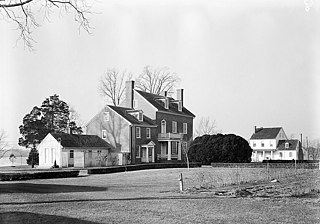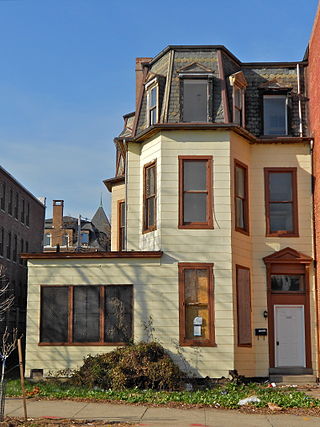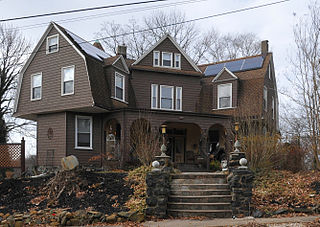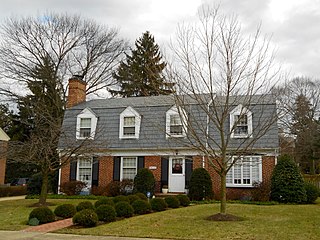
Druid Hill Park is a 745-acre (3.01 km2) urban park in northwest Baltimore, Maryland. Its boundaries are marked by Druid Park Drive (north), Swann Drive and Reisterstown Road, and the Jones Falls Expressway / Interstate 83 (east).

Bolton Hill is a neighborhood in Baltimore, Maryland, with 20 blocks of mostly preserved buildings from the late 19th century. It is listed on the National Register of Historic Places, preserved as a Baltimore City Historic District, and included within the boundaries of Baltimore National Heritage Area. The neighborhood is bounded by North Avenue, Mount Royal Avenue, Cathedral Street, Dolphin Street, and Eutaw Place. Bolton Hill is a largely residential neighborhood with three-story row houses with red brick, white marble steps, and high ceilings. There are also larger more ornate originally single-family houses, many houses of worship, parks, monuments, and a few large apartment buildings. Many significant residents have lived in the neighborhood, including F. Scott Fitzgerald, Woodrow Wilson, the Cone sisters, and Florence Rena Sabin.

Reservoir Hill, is a historic neighborhood in the city of Baltimore, Maryland, United States. It is located south of Druid Hill Park, north of Bolton Hill, east of Penn-North, and west of Jones Falls. It is bounded by Druid Park Lake Drive, the Jones Falls Expressway, North Avenue, and McCulloh Street. It is contained in the 21217 ZIP code.

Mayfield is a quaint and historic community in northeast Baltimore, Maryland. It is bounded by Erdman Avenue on the south, Chesterfield Avenue on the north, Crossland Avenue on the east and Lake Montebello on the north and west. Homeowners belong to the Mayfield Improvement Association.

Seton Hill Historic District is a historic district in Baltimore, Maryland. It was listed on the National Register of Historic Places in 1975.

Potter Hall is a historic home located at Williston, Caroline County, Maryland, United States. It is an early-19th-century, Federal-influenced house facing the Choptank River. The house was constructed in three sections: a tall 2+1⁄2-story Flemish bond brick structure built about 1808 adjoining a lower 2+1⁄2-story, two-bay-wide central section built about 1750, also of Flemish bond brick, then a frame single-story kitchen wing added in 1930. Each of the three sections has a gable roof. Potter Hall was originally settled by Zabdiel Potter, who in the mid-18th century built a wharf and the small brick house. He developed Potter's Landing into a key early port for the shipping of tobacco to Baltimore.
Hill House, also known as Cool Spring, is a historic home located on York Road at Parkton, Baltimore County, Maryland, United States. It is a large, 2+1⁄2-story brick mansard-roofed dwelling constructed about 1879. It features a four-paneled central entrance door flanked by round-arched sidelights and surmounted by a rectangular transom. The house presents a rural interpretation of the Second Empire style.

The David Bachrach House, also known as Gertrude Stein House, is a historic home located at Baltimore, Maryland, United States. It is a late 19th-century Victorian style frame structure consisting of two stories plus a mansard roof in height. It was constructed about 1886 and occupied by David Bachrach (1845-1921), a commercial photographer who figures prominently in the annals of American photographic history. Also on the property is a one-story brick building on a high foundation that was built for Ephraim Keyser (1850-1937) as a sculpture studio about 1890 and a one-story brick stable. Ephraim Keyser and Fannie (Keyser) Bachrach were brother and sister. Gertrude Stein (1874-1946) was a niece of Mrs. David Bachrach [Fannie (Keyser) Bachrach] and lived in this house for a short time in 1892.

St. Elizabeth of Hungary is a historic Roman Catholic church complex located within the Archdiocese of Baltimore in the Baltimore-Linwood neighborhood of Baltimore, Maryland, United States.

Old Pine Street Station, also known as the Old Western District Police Station House, is a historic police station located at Baltimore, Maryland, United States. It is a freestanding brick building of two stories raised on a partially exposed basement in the quintessential brick Victorian Gothic style. It was constructed 1877–78.

James E. Hooper House is a historic home located at Baltimore, Maryland, United States. It is a large Queen Anne style freestanding masonry structure, situated among the buildings of the Old Goucher College Buildings complex. It is a rectangular building with a steeply pitched gable roof, a small, two-story wing extending, and a 2+1⁄2-story bay window extension, with a small gable roof. There are two stories in the main section of the house, and two more stories in the gable. It is constructed of dark red bricks with terra cotta, brownstone, and granite trim. The exterior features a slate shingle roof, and a square oriel, three bays wide and one bay deep, made of wood, and painted green. The house was constructed in 1886 for James E. Hooper (1839–1908).

The Hans Schuler Studio and Residence is a historic home and artist studio located at Baltimore, Maryland, United States. It is an eclectic brick building constructed in two stages. The studio is one story high with a recessed skylight, and was designed by Baltimore architect Howard Sill and constructed in 1906; the residence is two stories tall plus a high, steep mansard story which was added in 1912. It combines elements from various fashionable styles and incorporating as ornament the work of sculptor Hans Schuler (1874-1951), for whom the building was constructed. It currently houses The Schuler School of Fine Arts and The Schuler Gallery.

Coca-Cola Baltimore Branch Factory is a historic factory complex located at Baltimore, Maryland, United States. It was constructed from 1921 to 1948 and built principally to house Coca-Cola's syrup-making operations. The complex is spread over a 9.4-acre (38,000 m2) site and includes a two-story brick syrup factory/sugar warehouse and an earlier two-story brick mattress factory that Coca-Cola acquired and adapted in the 1930s. Completed in 1948, the complex housed syrup-making operations as well as the Coca-Cola Company's chemistry department.

Little Montgomery Street Historic District is a national historic district in Baltimore, Maryland, United States. It is composed of approximately 15 19th century brick houses, some of which are double, that line the 100-block of West Montgomery Street and the northwestern portion of the 800 block of Leadenhall Street. All the buildings are small in scale and of brick construction, abut the sidewalks, are closely spaced, and are generally two to three stories high with two-bay façades. Nine of the structures are "half houses" that are only one room deep with a single pitch roof. The district is associated with a working class urban community where, throughout the 19th and early 20th centuries Baltimore's native poor, struggling German and Irish immigrants, and freed southern African-Americans lived side by side competing for the same space and the same railroad and port-related jobs.

Stone Hill Historic District is a national historic district in Baltimore, Maryland, United States. It is one of the original mill villages along the Jones Falls, having been developed circa 1845–1847 to house textile mill workers. Comprising seven blocks, the district includes 21 granite duplexes, a granite Superintendent's House, and a granite service building – all owned by Mount Vernon Mills from 1845 to 1925.

Oakenshawe Historic District is a national historic district in Baltimore, Maryland, United States. It comprises 334 buildings which reflect the neighborhood's development during the period 1890 to about 1926. The neighborhood evolved in two stages on the 19th century Wilson estate. The first phase of growth is represented by frame houses dating from 1890 to about 1910 reflecting vernacular interpretations of the Victorian Gothic and Italianate styles. The second stage of development began in the World War I era, when several developers transformed the property by constructing a neighborhood of brick "daylight" rowhouses in revival styles popular at the time.

Old Goucher College Buildings is a national historic district in Baltimore, Maryland, United States. It is an approximate 18-block area in the middle of Baltimore which developed in the late 19th and 20th centuries.

Windsor Hills Historic District is a national historic district in Baltimore, Maryland, United States. It is a cohesive residential suburb defined by rolling topography, winding, picturesque streets, stone garden walls, walks and private alley ways, early-20th century garden apartments, duplexes, and freestanding residences. Structures are predominantly of frame construction with locally quarried stone foundations. Windsor Hills developed over a period from about 1895 through 1929. The dominant styles include Shingle cottages, Dutch Colonial Revival houses, Foursquares, and Craftsman Bungalows.

Arcadia–Beverly Hills Historic District is a national historic district in Baltimore, Maryland, United States. It is a cohesive residential suburb comprising approximately 30 irregularly shaped blocks containing some 900 buildings. They are primarily freestanding masonry and frame houses set back from the streets with small front yards. Early-20th century suburban architectural styles represented in the district include foursquare, bungalows, early suburban villas, Colonial Revival, Tudor Revival, and Pueblo Revival. Also included are two churches, a 45-acre (180,000 m2) cemetery, and a variety of commercial buildings along Harford and Belair Roads. Herring Run Park provides a wooded park setting for the community. The earliest structure in the community was constructed in 1887, and the district had substantially achieved its existing form and appearance by 1950.

Bellona–Gittings Historic District is a national historic district located at Baltimore, Maryland.
























